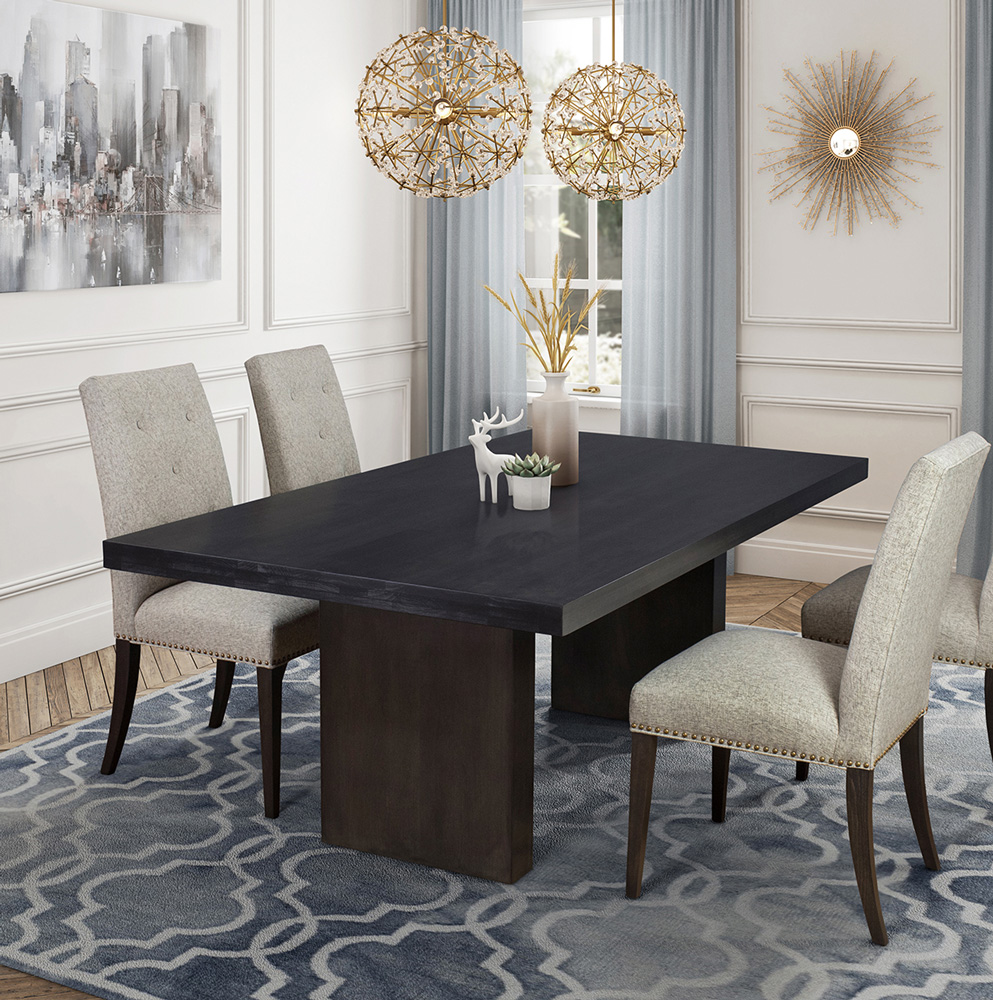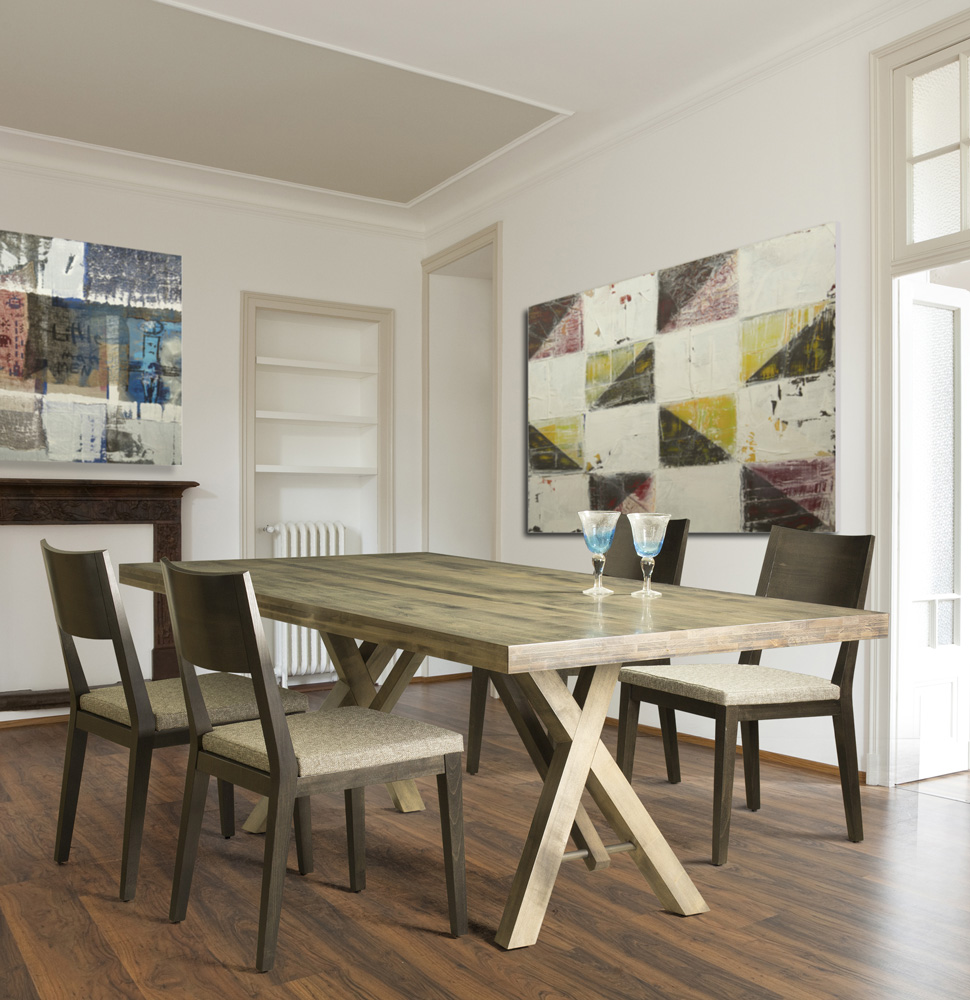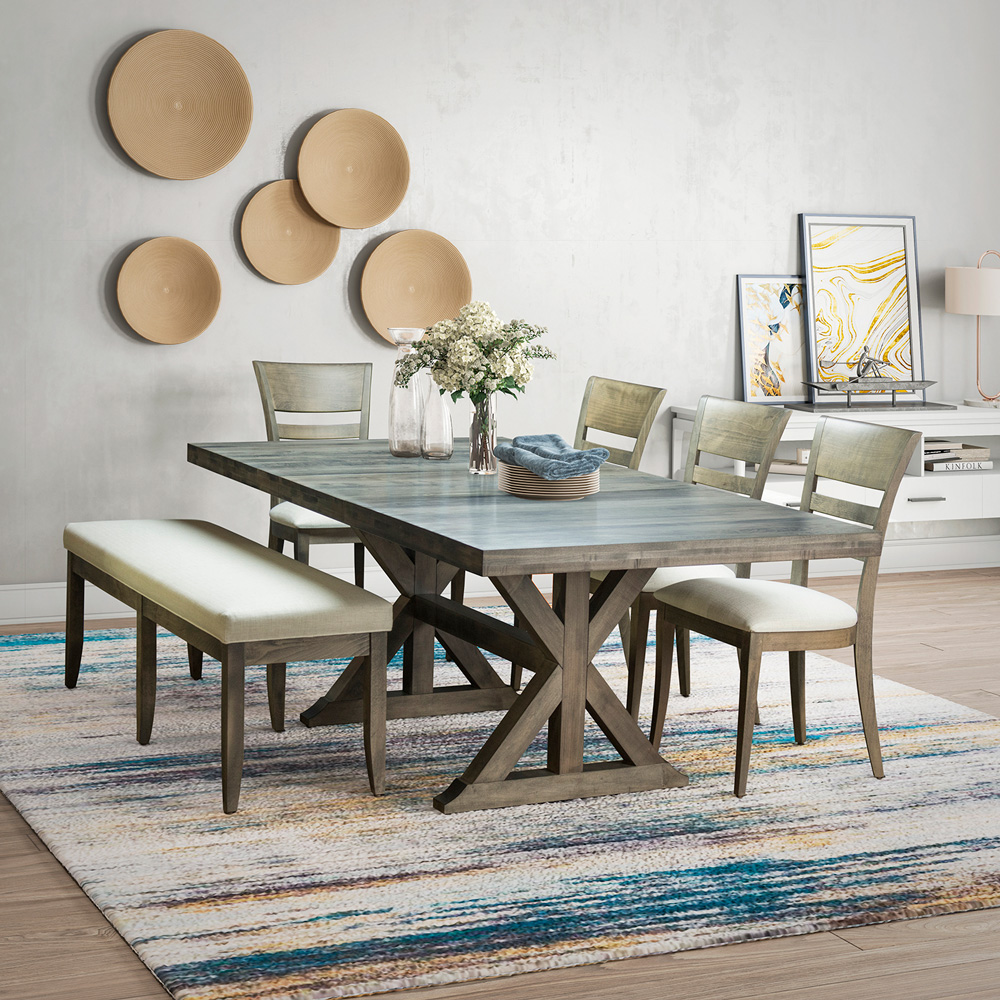Hey there, design enthusiasts! Are you looking to give your dining room a fresh new look that’s both classic and modern? Well, you’re in luck because today we’re diving into the world of transitional design – the perfect middle ground between traditional elegance and contemporary cool. Let’s explore how you can transform your dining space into a stylish haven that’ll impress your guests and stand the test of time.
What is Transitional Design?
Before we jump into the nitty-gritty, let’s quickly define what we mean by “transitional design.” Think of it as the Goldilocks of interior design – not too stuffy, not too avant-garde, but just right. It’s all about blending the comfort and warmth of traditional design with the clean lines and neutral colors of contemporary style. The result? A timeless design and balanced look that feels both fresh and familiar.

Now, let’s talk about how to bring this style into your formal dining room, starting with the star of the show – the dining furniture!
Dining Tables: The Heart of Your Space
Your dining table is the centerpiece of the room, so choosing the right one is crucial. Here are some ideas to consider:
- Material Matters: Look for dining room tables made of wood with a rich, warm tone. Oak, walnut, or cherry are excellent choices. For a more contemporary twist, consider a table with a wood top and metal legs.
- Shape it Up: Rectangular tables are classic, but don’t be afraid to mix it up. A round table can add softness to a room with lots of straight lines, while an oval table offers the best of both worlds.
- Size Matters: Make sure your table is proportionate to your room. You want enough space for people to move around comfortably. You might want to consider dining room tables that expand for extra guests.
- Details, Details: Look for tables with subtle details and features like slightly tapered legs or a gently beveled edge. These small touches add interest without going overboard.
Dining Chairs: Comfort Meets Style
Now that you’ve got your table sorted, let’s talk seating:
- Mix and Match: One of the coolest things about transitional style is that you can mix different dining chair styles. Try pairing upholstered chairs with wooden ones for a dynamic look.
- Upholstery Options: If you go for upholstered chairs, choose fabrics in neutral tones like beige, gray, or soft blue. For a bolder statement, consider a subtle pattern or texture.
- Wood Finishes: For wooden chairs, look for finishes that complement your table without matching exactly. A slightly lighter or darker shade can create a lovely, layered look.
- Sleek Silhouettes: Choose side chairs with clean lines and simple shapes. Avoid anything too ornate or ultra-modern.
- Comfort is Key: Remember, these chairs aren’t just for show. Make sure they’re comfortable enough for long dinner parties!
Benches: A Trendy Alternative
Want to shake things up a bit? Consider adding a bench to one side of your table:
- Versatility: Benches can accommodate more people in a pinch and are great for casual family dinners.
- Style Options: Choose a bench that complements your chairs. A wooden bench with a cushion can be a great transitional piece.
- Placement: Use a bench on one side of a rectangular table, paired with chairs on the other side and ends.
Sideboards and Buffets: Storage with Style
Don’t forget about storage! A sideboard or buffet can be both functional and stylish:
- Clean Lines: Look for pieces with simple, clean lines that echo the style of your table and chairs.
- Material Mix: A wooden sideboard with metal hardware can be a perfect transitional piece.
- Display Space: Choose a piece with both closed storage and open shelving to display your favorite dishes or decor items.
Lighting: Set the Mood
Lighting can make or break your dining room‘s ambiance:
- Chandelier Chic: A statement chandelier can be a great focal point. Look for designs that blend traditional shapes with modern materials.
- Pendant Power: For a more contemporary feel, try a cluster of pendant lights over your table.
- Layered Lighting: Don’t forget about wall sconces or a floor lamp in the corner for additional ambiance.
Rugs: Ground Your Space
A rug can tie your whole room together:
- Size Matters: Make sure your rug is large enough to accommodate your table and chairs, even when they’re pulled out.
- Pattern Play: A subtle pattern or texture can add interest without overwhelming the space.
- Color Choices: Stick to neutral tones or soft, muted colors that complement your overall color scheme.
Wall Decor: The Finishing Touch
Your walls are the perfect canvas to express your style:
- Mirror, Mirror: A large mirror can make your space feel bigger and brighter.
- Art Attack: Choose artwork that speaks to you. Abstract pieces can add a contemporary touch, while landscapes or still life pieces can lean more traditional.
- Gallery Wall: Create a gallery wall with a mix of photos, prints, and small mirrors for an eclectic yet cohesive look.
Color Palette: Keep it Neutral (But Not Boring!)
Transitional style typically favors a neutral color palette, but that doesn’t mean it has to be dull:
- Base Colors: Start with a foundation of whites, creams, grays, or warm beiges.
- Accent Colors: Add depth with muted blues, soft greens, or warm terra cottas.
- Texture is Key: Use different textures to add interest – think nubby fabrics, smooth woods, and glossy ceramics.
Accessories: The Devil’s in the Details
The right accessories can really bring your transitional dining room to life:
- Table Settings: Mix traditional tableware with modern flatware for an interesting juxtaposition.
- Centerpieces: Keep it simple with a low vase of fresh flowers or a collection of candles in varying heights.
- Window Treatments: Choose simple, elegant curtains in a neutral tone or with a subtle pattern.
- Plants: Add some life to your space with a few well-placed plants. A large fiddle leaf fig in the corner or some small potted herbs on the sideboard can work wonders.
Putting It All Together

Now that we’ve covered all the elements, let’s talk about how to bring it all together:
1. Balance is Key
The heart of transitional style lies in striking the perfect balance between traditional and contemporary elements. This doesn’t mean you need an exact 50/50 split, but rather a harmonious blend that feels cohesive.
For example, if you’ve fallen in love with a beautiful, ornate wooden table with carved details, you might want to pair it with sleek, modern chairs in a neutral upholstery. This combination allows the table to shine while the chairs provide a contemporary counterpoint.
Similarly, if you have a very modern, glass-top table, you could balance it with more traditional upholstered chairs with button-tufted backs. The key is to ensure that no single style overwhelms the other.
This balance extends to every aspect of your room. If you have traditional wainscoting on the walls, consider a modern abstract painting above it. Or if you’ve selected a contemporary sideboard, display some vintage dinnerware or a traditional mirror above it.
Remember, contrast creates interest. The juxtaposition of old and new, ornate and simple, is what gives transitional style its unique appeal.
2. Quality Over Quantity
In a transitional dining room, less is often more. Instead of filling every inch of space, focus on selecting fewer, individual pieces that really speak to you. This approach not only creates a more sophisticated look but also allows each piece to shine.
Invest in a well-made dining table and chairs – these are the workhorses of your dining room and will see daily use. A quality sideboard or buffet can serve you for years, providing both storage and style.
When it comes to decor, choose items thoughtfully. A single, stunning piece of art can have more impact than a wall cluttered with smaller frames. A beautiful, oversized vase with simple branches can make a stronger statement than multiple smaller accessories.
This doesn’t mean your room should feel sparse. Rather, it should feel intentional and curated. Each item should earn its place in the room, contributing to the overall aesthetic and functionality.
3. Let It Breathe
Transitional style embraces a sense of spaciousness and light. Resist the urge to fill every corner or cover every surface. Empty space, or “negative space” in design terms, is crucial in creating a calm, welcoming atmosphere.
Allow for clear pathways around your dining table and chairs. If you have a beautiful view, don’t block it with heavy curtains or too much furniture. Let natural light flow into the space.
This principle also applies to your walls and surfaces. You don’t need to hang art on every wall or place accessories on every flat surface. Sometimes, a bare wall can provide a restful visual break and highlight the pieces you do choose to display.
In your china cabinet or on open shelving, resist the temptation to pack in every dish and glass you own. Instead, create thoughtful arrangements with space between items. This not only looks more stylish but also makes it easier to see and appreciate each piece.
4. Personal Touch
While following design principles is important, your dining room should ultimately reflect you and your family. This is where you’ll share meals, make memories, and spend time with loved ones. It should feel personal and lived-in, not like a showroom.
Display items that tell your story. Maybe it’s your grandmother’s antique serving platter, or a set of colorful bowls you picked up on your travels. These personal touches add character and warmth to your space.
Consider creating a small gallery wall with family photos, or display your child’s artwork in elegant frames. If you’re a wine enthusiast, incorporate a beautiful wine rack. Love books? A small bookshelf with your favorite cookbooks can add personality.
Don’t be afraid to break the “rules” a little if it means incorporating something you love. A quirky vintage lamp or an unusual piece of art can become a great conversation starter and make your space uniquely yours.
5. Flexibility is Your Friend
One of the greatest advantages of transitional style is its adaptability. Because it’s not tied to a specific era or strict set of rules, you can easily update your look over time without a complete overhaul.
Start with a neutral base in your larger, more expensive pieces like your dining table, chairs, and sideboard. Then, use smaller items to inject color, pattern, and current trends. This way, you can refresh your look seasonally or as your tastes change, without breaking the bank.
For example, you might switch out your rug and curtains to bring in different colors or patterns. Change your artwork periodically to give the room a new focal point. Update your table settings with new placemats, napkins, or a table runner.
Even small changes can have a big impact. New hardware on your sideboard, different lampshades, or a new centerpiece can give your room a fresh feel.
This flexibility also allows your room to evolve with you over time. As you acquire new pieces in your dining room set or your style preferences shift, you can gradually update your space while maintaining its overall transitional feel.
Creating a transitional dining area is all about finding that sweet spot between classic and contemporary. It’s a style that’s built to last, allowing you to tweak and update as your tastes evolve without needing a complete overhaul.
Remember, the most important thing is that your dining room feels like you. It should be a space where you’re comfortable, whether you’re hosting a formal dinner for a special occasion or enjoying a casual family meal. So take these tips as a starting point, but don’t be afraid to experiment and make the space your own.
Shop Transitional Dining Room Furniture at California Dining & Barstools
California Dining & Barstools offers an exquisite collection of dining sets, chairs, barstools and pub tables designed to achieve a transitional design look. Our pieces seamlessly blend traditional elegance with contemporary simplicity, providing a versatile style that complements various interiors. Whether you’re looking for a casual dining set or a more formal one, our selection includes a range of finishes, materials, and styles to suit your taste. To explore our beautiful collection and find the perfect pieces for your home, visit our furniture store in two Bay Area locations — Sunnyvale and Pleasant Hill.
Happy decorating, and here’s to many wonderful meals in your new transitional dining room!
